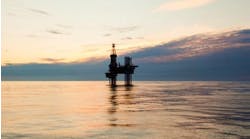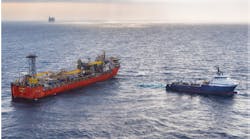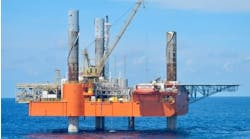C130 aircraft operated by the US Coastguard monitor ice movement in the North West Atlantic.
The US Coast Guard is modernizing its surveillance aircraft. The program consists primarily of new software packages from Swedish Space Corporation, based in Solna, Sweden. Three skid-mounted systems housing the latest MSS 5000 software will be aboard the Coast Guard's C 130 aircraft as operational requirements demand.
Initially, two of the systems will be used for International Ice Patrol duties that will include monitoring ice threats to the Hibernia, Terra Nova, and White Rose fields. The third system will be used for maritime environmental protection. Because the systems are skid-mounted, they will be interchangeable between aircraft.
The US Coast Guard has operated International Ice Patrol missions since 1914 and today the patrols are conducted using side-looking airborne radar (SLAR) throughout the ice season, which runs from February until August. The patrol was introduced to provide shipping in the north Atlantic with "limit of all known ice," or LAKI, reports that contain up-to-date information about iceberg movement and is now of equal importance to oil field activities off Newfoundland.
Norwegian slick hunt
The MSS 5000 system was originally developed for environmental maritime surveillance. It has been demonstrated as highly effective for detecting small targets and also for mapping oil spills. The newest generation of maritime surveillance system is designed to give a more effective Coast Guard operation for a wide range of tasks such as the monitoring of economic exclusion zones, search and rescue, and fishery control.
Previous customers for the MSS 5000 include the Norwegian Pollution Control Authority - Statens Forurensningstillsyn (SFT) - which maintains patrols with light aircraft over the Norwegian sector of the North Sea. The Fairchild Merlin IIIB aircraft patrol the entire Norwegian coastline every week and the Norwegian oil fields daily.
The SFT air crews have the job of spotting oil spills and identifying their source from the air. They are supported in this task by images from satellites whose tracks regularly follow the Norwegian coast. The high altitude of the satellites and the resolution of the images they supply enable huge areas of the North Sea to be observed in a single pass. The satellite images are received in Tromso where they are studied for any indications of oil pollution. If the trained observers spot a suspicious indication, an alert goes to the SFT which will send an aircraft to investigate.
The SFT was the first organization to use the MSS 5000 and has experienced a significant improvement in the capacity of its surveillance. In the first few months of use, operators reported spotting a fleet of fishing boats at a distance of 70 km and an oil spill at 42 km. This amounts to a 50% improvement in detection range compared with the previous system. These benefits also combine with improved handling and data linking with the new system.
Oil spill tracking capability
The sensor system used by the MSS 5000 overcomes the difficulty of spotting oil slicks from the air by looking not at the oil, but at the contrast against the sea that surrounds it. From an altitude of just 2,500 ft, the radar monitors a swath of sea extending to more than 40 nautical miles on either side. The predominant reflections received by the SLAR take the form of enhanced clutter generated by the irregular surface of the sea. The calming effect of oil on seawater consequently betrays the existence of an oil slick as it reduces the amount of clutter from the affected area.
Because the aircraft is able to cover such a wide expanse of sea, polluting vessels or platforms may not be aware that they have been observed until the aircraft appears directly overhead. The advanced battery of conventional and infra-red cameras that form part of the MSS 5000 package carried by the aircraft is used to identify the offender and to provide the evidence needed for a successful conviction.
The Swedish Space system was first used for pollution monitoring in the North Sea in the 1980s. It has been subjected to continual improvement since then and the new MSS 5000 system has also been delivered to the Polish Navy through a contract with the maritime office in Gdynia. The Greek and Swedish Coast Guards also operate MSS 5000 systems.
For more information, contact Olov Fäst, Swedish Space Corporation. Tel: +46 8 62 76 200, Fax: +46 8 98 70 69, Email: [email protected]




